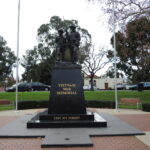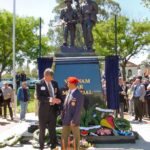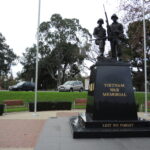The Vietnam War Memorial was dedicated on 15 October 2006 and dedicated to the 58 servicemen from South Australia who lost their lives in the Vietnam War. Standing nearly five metres tall, this memorial is found next to the Torrens Parade Ground off of Kintore Avenue. This site features two black granite murals entitled Passage to Freedom and Resettle Intergration Contribution which feature Vietnamese historical narratives. The attached etchings display a boat of Vietnamese refugees and a collage of various occupations respectively. These murals, alongside the sculpture of side-by-side comrades in arms, was constructed to demonstrate a sense of joint ownership of the memorial for both Australian and Vietnamese veterans.
During Australia’s involvement in this conflict, more than 60,000 Australians served in Vietnam. This conflict both within Australia and globally was highly contested as protest movements saw support and momentum. Australia’s involvement in Vietnam lasted for 10 years as the military effort was slowly withdrawn from late 1970 to late 1972.
The Vietnam War Memorial Project
Planning for a South Australian Vietnam War Memorial began on ANZAC Day 2003 and was coordinated through the cooperation of the Returned and Services League, Vietnamese Veterans’ Association, Vietnam Veterans’ Federation and Vietnam Veterans’ Association. Their aim was to construct a monument that acknowledged the camaradarie of servicemen and remembered all those that served in the Vietnam War. The project officially launched through a public awareness program and car raffle in April of the following year.
The sculptor of this piece was a fellow Vietnam Veteran James Martin who worked alongside bronze caster Tim Thompson. Their design was chosen to represent an Australian Digger and his Vietnamese comrade in a reflective mood after returning from a clearing patrol. Following the aims of the project, this design encapsulates the camaraderie between these two individuals whilst their reflective mood was also designed to signify their contemplation of the future. Although the engraving of the surrounding pavers was done interstate, the entire memorial (including pavers) were South Australian made.
Unveiling
The Vietnam War Memorial was unveiled to the public on Sunday 15 October 2006. The guests were welcomed by the Master of Ceremonies John Spencer and by Kaurna Elder Lewis O’Brien. There was almost 3,000 attendies on the day which included two hundred next of kin of the 58 South Australian servicemen this memorial is dedicated to. The official unvieling was performed by Lieutenant General Sir Donald Dunstan, the Commander of the Australian Force Vietnam in both 1971 and 1972.
The day faced some controversy between the Adelaide Memorial Committee and the federal government due to the flying of the former Republic of Vietnam (RVN) flag during the ceremony. Though this flag is not formerly recognized by the federal government, its abscence from the dedication would have been counter-productive to all the work and costs that the Vietnamese Veterans put into this project. The outcomes of this conflict meant that the delegation from the federal government was abscent during this dedication ceremony.
Vietnam Veterans Day
In 1987, Prime Minister Bob Hawke announced the designation of 18 August as Vietnam Veterans’ Day in Australia. The date was chosen to commemorate the Battle of Long Tan in 1966 where ANZAC troops fought against soldiers from the North Vietnamese Army (Viet Cong) for almost four hours. Outnumbered at an estimated 20 to 1, 105 men from Australia’s Delta Company 6 RAR and three New Zealanders from their 161 Battery, Royal New Zealand Artillery held off this attack in a rubber plantation roughly a couple thousand metres away from the Australian Task Force base at Nui Dat.
In commemoration of this day, the Vietnam Veterans’ Federation conducts a simple reflection service at this memorial at 3.00pm each year. 18 roses are placed on the Memorial during this service in memory of the 17 servicemen who died during the Battle of Long Tan and the one individual who died from their wounds several days after.







Comments